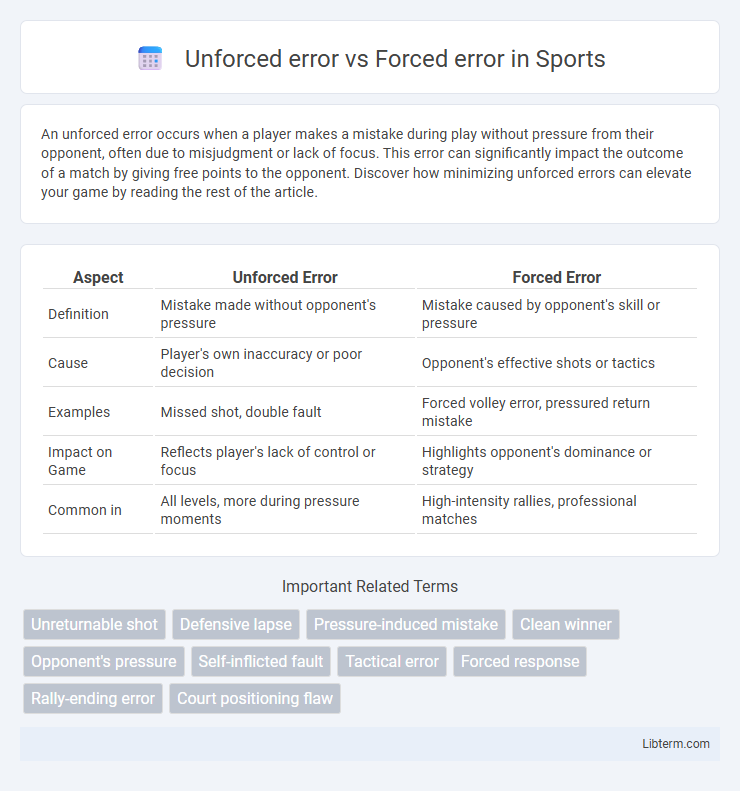An unforced error occurs when a player makes a mistake during play without pressure from their opponent, often due to misjudgment or lack of focus. This error can significantly impact the outcome of a match by giving free points to the opponent. Discover how minimizing unforced errors can elevate your game by reading the rest of the article.
Table of Comparison
| Aspect | Unforced Error | Forced Error |
|---|---|---|
| Definition | Mistake made without opponent's pressure | Mistake caused by opponent's skill or pressure |
| Cause | Player's own inaccuracy or poor decision | Opponent's effective shots or tactics |
| Examples | Missed shot, double fault | Forced volley error, pressured return mistake |
| Impact on Game | Reflects player's lack of control or focus | Highlights opponent's dominance or strategy |
| Common in | All levels, more during pressure moments | High-intensity rallies, professional matches |
Understanding Unforced and Forced Errors
Unforced errors occur when a player makes a mistake during an easy or routine shot without pressure from an opponent, reflecting a lapse in concentration or technique. Forced errors result from an opponent's aggressive or skillful play, compelling the player to attempt a difficult shot that leads to a mistake. Understanding the difference between unforced and forced errors is essential for improving tennis strategy and identifying areas for skill development.
Defining Unforced Errors in Sports
Unforced errors in sports occur when a player makes a mistake without any direct pressure from the opponent, such as missing an easy shot or failing to control the ball accurately. These errors reflect lapses in concentration, technique, or decision-making rather than external factors. Understanding unforced errors is crucial for improving performance and minimizing avoidable mistakes in competitive play.
What Constitutes a Forced Error?
A forced error occurs when a player makes a mistake due to pressure from the opponent's skillful shots, such as powerful serves, deep groundstrokes, or well-placed angles, which limit the player's ability to execute an ideal return. Unlike unforced errors, caused by a player's own lapses in concentration or technique, forced errors result directly from the opponent's strategic play and shot quality. Understanding the distinction helps players improve defensive positioning and shot anticipation to reduce the incidence of forced errors during a match.
Key Differences Between Unforced and Forced Errors
Unforced errors occur when a player makes a mistake in a situation where they have full control, typically due to poor technique or lapse in concentration, such as hitting the ball into the net or out of bounds without pressure from the opponent. Forced errors happen when the opponent applies pressure with well-placed shots or aggressive play, forcing the player into an error despite their best effort. The key difference lies in the source of the error: unforced errors stem from the player's own shortcomings, while forced errors arise from the opponent's skill and strategic play.
Impact of Errors on Game Outcomes
Unforced errors, such as missed easy shots or poor placement, directly increase the likelihood of losing points by giving opponents free opportunities to score, significantly impacting match momentum. Forced errors occur when players attempt difficult shots under pressure, often reflecting an opponent's strategic advantage but still contributing to score shifts. Both error types alter game outcomes by affecting player confidence, influencing rally length, and dictating match tempo.
Common Causes of Unforced Errors
Unforced errors in tennis typically result from player mistakes such as poor footwork, failure to maintain balance, or incorrect shot selection, rather than pressure from the opponent. Common causes include lack of concentration, improper technique, and mental fatigue, which lead to mishits like hitting the ball into the net or out of bounds. Training to improve focus, consistent stroke mechanics, and physical conditioning can significantly reduce unforced errors and enhance overall match performance.
Factors Leading to Forced Errors
Forced errors in tennis occur when a player makes a mistake due to the opponent's aggressive play, such as powerful shots or strategic placement. Factors leading to forced errors include high ball speed, sharp angles, unpredictable spin, and increased pressure from well-constructed rallies. These elements limit the defender's reaction time and positioning, causing errors despite optimal effort.
Strategies to Minimize Unforced Errors
Minimizing unforced errors in tennis involves focusing on consistent footwork, maintaining a stable racket grip, and practicing deliberate shot selection to reduce mis-hits. Players should regularly engage in drills that simulate match pressure, enhancing decision-making and reducing forced mistakes stemming from poor technique. Emphasizing mental focus and controlled aggression ensures players avoid unnecessary risks, thereby lowering unforced errors and improving overall match performance.
How to Capitalize on Forced Errors
Forced errors occur when an opponent makes a mistake under pressure, providing opportunities to win points by maintaining aggressive shot placement and consistent court positioning. Capitalizing on forced errors requires anticipating opponents' weaknesses and exploiting them with precise, high-risk shots that reduce their margin for error. Effective footwork and rapid recovery enable sustained pressure, increasing the likelihood of inducing additional forced errors throughout the rally.
Analyzing Errors: Insights for Athletes and Coaches
Analyzing unforced errors, which occur due to an athlete's own mistake under minimal pressure, helps identify technical flaws and mental lapses, enabling targeted training to improve consistency. Forced errors, caused by an opponent's skillful play or challenging conditions, reveal areas where athletes need to enhance their defensive strategies and adaptability. Coaches leverage insights from both error types to develop customized practice routines that strengthen weaknesses and optimize performance under competitive stress.
Unforced error Infographic

 libterm.com
libterm.com